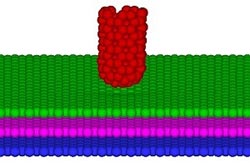Nanotribology: Tubular probes

Atomistic simulations show that short, capped single-walled carbon nanotubes (red) can elucidate the tribological properties of graphene surfaces. Copyright : 2011 Elsevier <br>
Studying microscopic interactions at single asperities is vital for the understanding of friction and lubrication at the macroscale. Surface probe instruments with carbon nanotube tips may enable such investigations, as now demonstrated in a theoretical study led by Ping Liu and Yong-Wei Zhang at the A*STAR Institute of High Performance Computing1. The researchers showed that short, single-walled, capped carbon nanotubes are able to capture the frictional characteristics of graphene with atomic resolution.
“For an ideal probing tip, its dimension should be as small as possible, its rigidity should be as large as possible, its geometry should be well-defined, and it should be chemically inert,” explains Liu. The combination of such characteristics would allow surface characterization with atomic resolution while ensuring a long lifetime and geometrical, chemical and physical stability of the tip.
Carbon nanotubes, in particular short ones, are of great interest due to their inherent strong carbon–carbon bonds, which allows them to withstand buckling and bending deformation and recover to their original shape after deformation. Capped tubes in turn offer improved chemical stability and stiffness in comparison to non-capped tubes. These considerations indicate that short, capped single-walled carbon nanotubes may be ideal imaging probe tips.
As it is not yet possible to use such tips in experimental setups, to test this hypothesis Liu and Zhang performed large-scale atomistic simulations focusing on the interaction between such nanotube probing tips and graphene (see image)—a carbon material that is ideal for surface coating lubrication. “Because of advances in the development of accurate atomic potentials and massive parallel computing algorithms, atomistic simulations not only enable us to determine the probing characteristics of such tips, but also to investigate the frictional and defect characteristics of graphene with atomic resolution,” says Liu.
The simulations could capture the dependence of the friction and average normal forces on tip-to-surface distance and number of graphene layers. The researchers analyzed and interpreted the observed characteristics in terms of different types of sliding motions of the tip across the surface, as well as energy dissipation mechanisms between the tip and underlying graphene layers. They could further identify clear signatures that distinguish the motion of a tip across a point defect or the so-called Stone-Thrower-Wales defect, which is thought to be responsible for nanoscale plasticity and brittle–ductile transitions in the graphene carbon lattice. “Our simulations provide insight into nanoscale friction and may provide guidelines on how to control it,” says Liu.
The A*STAR-affiliated researchers contributing to this research are from the Institute of High Performance Computing
Media Contact
All latest news from the category: Information Technology
Here you can find a summary of innovations in the fields of information and data processing and up-to-date developments on IT equipment and hardware.
This area covers topics such as IT services, IT architectures, IT management and telecommunications.
Newest articles

Properties of new materials for microchips
… can now be measured well. Reseachers of Delft University of Technology demonstrated measuring performance properties of ultrathin silicon membranes. Making ever smaller and more powerful chips requires new ultrathin…

Floating solar’s potential
… to support sustainable development by addressing climate, water, and energy goals holistically. A new study published this week in Nature Energy raises the potential for floating solar photovoltaics (FPV)…

Skyrmions move at record speeds
… a step towards the computing of the future. An international research team led by scientists from the CNRS1 has discovered that the magnetic nanobubbles2 known as skyrmions can be…





















